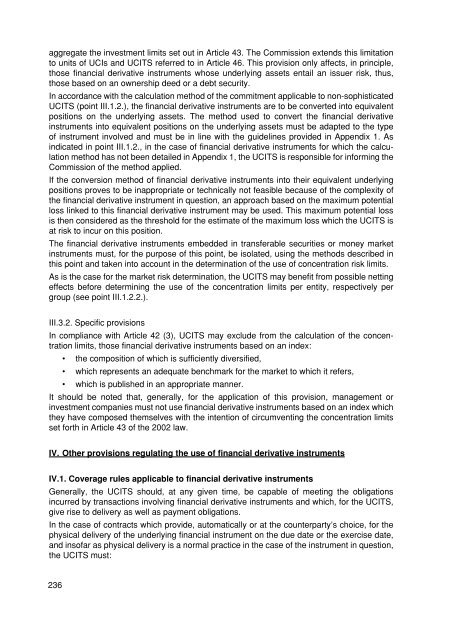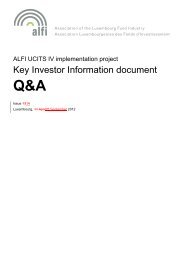law of 20 December 2002 - Alfi
law of 20 December 2002 - Alfi
law of 20 December 2002 - Alfi
- No tags were found...
You also want an ePaper? Increase the reach of your titles
YUMPU automatically turns print PDFs into web optimized ePapers that Google loves.
aggregate the investment limits set out in Article 43. The Commission extends this limitationto units <strong>of</strong> UCIs and UCITS referred to in Article 46. This provision only affects, in principle,those financial derivative instruments whose underlying assets entail an issuer risk, thus,those based on an ownership deed or a debt security.In accordance with the calculation method <strong>of</strong> the commitment applicable to non-sophisticatedUCITS (point III.1.2.), the financial derivative instruments are to be converted into equivalentpositions on the underlying assets. The method used to convert the financial derivativeinstruments into equivalent positions on the underlying assets must be adapted to the type<strong>of</strong> instrument involved and must be in line with the guidelines provided in Appendix 1. Asindicated in point III.1.2., in the case <strong>of</strong> financial derivative instruments for which the calculationmethod has not been detailed in Appendix 1, the UCITS is responsible for informing theCommission <strong>of</strong> the method applied.If the conversion method <strong>of</strong> financial derivative instruments into their equivalent underlyingpositions proves to be inappropriate or technically not feasible because <strong>of</strong> the complexity <strong>of</strong>the financial derivative instrument in question, an approach based on the maximum potentialloss linked to this financial derivative instrument may be used. This maximum potential lossis then considered as the threshold for the estimate <strong>of</strong> the maximum loss which the UCITS isat risk to incur on this position.The financial derivative instruments embedded in transferable securities or money marketinstruments must, for the purpose <strong>of</strong> this point, be isolated, using the methods described inthis point and taken into account in the determination <strong>of</strong> the use <strong>of</strong> concentration risk limits.As is the case for the market risk determination, the UCITS may benefit from possible nettingeffects before determining the use <strong>of</strong> the concentration limits per entity, respectively pergroup (see point III.1.2.2.).III.3.2. Specific provisionsIn compliance with Article 42 (3), UCITS may exclude from the calculation <strong>of</strong> the concentrationlimits, those financial derivative instruments based on an index:• the composition <strong>of</strong> which is sufficiently diversified,• which represents an adequate benchmark for the market to which it refers,• which is published in an appropriate manner.It should be noted that, generally, for the application <strong>of</strong> this provision, management orinvestment companies must not use financial derivative instruments based on an index whichthey have composed themselves with the intention <strong>of</strong> circumventing the concentration limitsset forth in Article 43 <strong>of</strong> the <strong>20</strong>02 <strong>law</strong>.IV. Other provisions regulating the use <strong>of</strong> financial derivative instrumentsIV.1. Coverage rules applicable to financial derivative instrumentsGenerally, the UCITS should, at any given time, be capable <strong>of</strong> meeting the obligationsincurred by transactions involving financial derivative instruments and which, for the UCITS,give rise to delivery as well as payment obligations.In the case <strong>of</strong> contracts which provide, automatically or at the counterparty’s choice, for thephysical delivery <strong>of</strong> the underlying financial instrument on the due date or the exercise date,and ins<strong>of</strong>ar as physical delivery is a normal practice in the case <strong>of</strong> the instrument in question,the UCITS must:236
















